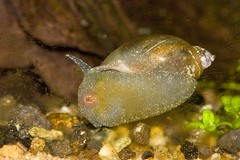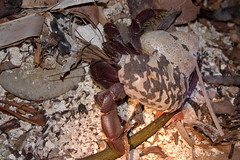I remember the brief discussion in Invert Biology about the 100+ year old mystery of the "y-larvae" crustacean. The jist of the conversation was that there was still much to learn about larval development of many crustaceans and there were some which were known as larvae but not as adults, for instance... "y-larvae" (also known as Facetotectans), a taxa of crustaceans which is described solely on the basis of the naupliar and cyprid larval stages.
Pachenik's Invertebrate Biology, the standard undergraduate textbook for invert biology/zoology, doesn't mention y-larva at all, while Brusca & Brusca's Invertebrates, 2nd Edition, gives them a single image and a one paragraph nod as members of the subclass Thecostraca, infraclass Facetotecta:
Infraclass Facetotecta
Monogeneric (Hansenocaris): The "y-larvae", a half-dozen small (250-620 μm) marine nauplii and cyprids (Figure 16.16I). Although known since Hansen's original description in 1899, the adult stage of these animals has still not been identified (although it has been suggested that they might be the "missing" larval progeny of sexual reproduction in tantulocarids). The prehensile antennules and hooked labrum of the y-cyprids suggest that the adults are parasitic. For details see Høeg and Kolbasov (2002).
Fortunately, The Atlas of Marine Invertebrate Larvae had more information on them, including illustrations of both nauplius and cypris y-larvae.
had more information on them, including illustrations of both nauplius and cypris y-larvae.
Kevin recently wrote up a great piece on the related Rhizocephalans at Deep Sea News complete with pictures from his own research. Catalogue of Organisms has a nice quick review of the parasites of subclass Thecostraca with a focus on the y-larvae and a description of the naupliar and cyprid stages. As mentioned in both those articles it is the cyprid larval morphologies that links all the Thecostraca species together.
This week an open access research article in BioMed Central's BMC Biology significantly extends the knowledge of these potentially important crustaceans. In their paper Henrik Glenner, Jens Høeg, Mark Grygier, and Yoshihisa Fujita report both a great diversity of y-larvae and document a new metamorphic stage of development.
In recent years the number of Facetotecta species has increased as new species have been described worldwide. The author's study area, Sesoko Island near Okinawa, Japan, was also the area of intensive sampling for Facetotectans. That sampling revealed 40 new species, and a density that made y-larvae a significant portion of the plankton, suggesting that the adult form may be ecologically important as well.
What I found most interesting in the paper, however, was the inducing and documentation of a previously unobserved juvenile stage of y-larvae. Up to now all y-larvae were observed as one of 5 naupliar instars or the next stage, a non-feeding cyprid. No one has found or been able to raise y-larvae past this cyprid stage.

The authors tried several compounds known to induce metamorphosis in the cyprid stage of related parasitic barnacles. They found that only 20-hydroxyecdysone (20-HE) induced metamorphosis in the y-cyprid. They then used photo and video to document the successful metamorphosis of the cyprids exposed to 20-HE. The cyprids transformed from an articulated, segmented form to a simple, unsegmented, pulsating, slug-like juvenile stage, which the authors have called the ypsigon. The ypsigon is without a gut, but has very visible fat globules throughout its body. The cyprid eyes and muscles are visible but degenerating in the ypsigon as well. The ypsigons underwent a molt 24 hours post metamorphosis as well. The study was terminated by preserving the the juveniles at 48h post metamorphosis.

This same morphological larval devolving has also been recently described in the vermigon stage of Rhizocephala, a connection that is a "stuning example of convergent evolution." This also suggests that the adult form of the y-larvae, when finally found, will be endoparasitic. The authors note that the analogy with Rhizocephalans suggests that the adult form will also have a "highly simplified structure" and that this possibility may explain why the adult form remains so hard to find.
Glenner, H., Hoeg, J., Grygier, M., Yoshihisa, F. (2008).
Induced metamorphosis in crustacean y-larvae: Towards a solution to a 100-year-old riddle. BMC Biology, 6(21) DOI:
10.1186/1741-7007-6-21.
Aditional pictures are in the PDF of the paper and videos of the metamorphosis are available on the BioMed Central website:
- Free swimming y-cyprid (mpg, 5.85 MB)
- Ypsigon partially escaped from y-cyprid (mpg, 8.81 MB)
- Ypsigon just escaped from y-cyprid (mpg, 7.2 MB)
- Ypsigon after escape from y-cyprid (mpg, 8.93 MB)
- Free ypsigon in process of molting (mpg, 6.94 MB)

















































